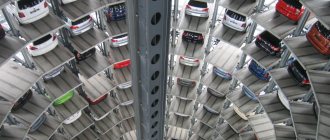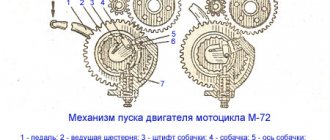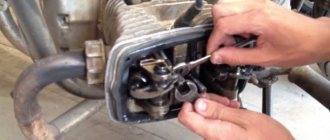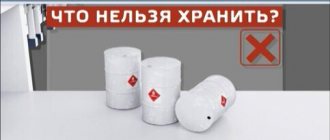Structurally, the aircraft is no more complicated than a modern passenger car. But in the cockpit there are countless buttons and toggle switches, but there are none on the dashboard of the car. Why is that?
There are several reasons. Firstly, aesthetics and comfort. Secondly, it is vital for the pilot to diagnose the problem right away. “On the ground” a motorist will always have time to stop by for diagnostics. Thirdly, dealers make good money on diagnostics.
Therefore, automakers provide a system of warning lamps on the instrument panel, which signal problems in technology or electronics. One such indicator is the EPC icon. What does it mean? What to fear and where to run? More on this below.
What does the EPC icon mean on the car dashboard?
The vehicle's instrument panel may display various types of messages indicating that one of the components is not working correctly or that the vehicle is malfunctioning. One of them is the EPC - Electronic Power Control indicator. But in what cases can an EPC error appear on the dashboard?
Electronic Power Control (EPC) is a computerized ignition and engine control system used in VAG (better known as Volkswagen Group) vehicles.
Many car owners, seeing an indicator on the instrument panel, confuse it with an error in the ABS or ESP system, the latter of which is responsible for the car's road stabilization system (vehicle stability control system). ABS and ESP are anti-skid systems that protect the vehicle from loss of traction during driving and braking. As for the EPC warning light, for many this abbreviation on the dashboard remains a mystery. In fact, this illuminated EPC warning indicates problems in the car associated with power failures .
Photo: automobileglobe.com
Unfortunately, an EPC error can mean almost anything, including significant problems ranging from incorrect values from engine sensors to a brake light failure or an error in the coolant temperature sensor. Typically, to determine the cause of the failure, it is necessary to use a diagnostic computer or a special diagnostic application installed on a smartphone, which must be connected to the vehicle's diagnostic connector.
It is noteworthy that the EPC indicator is found mainly on Volkswagen cars or cars manufactured by the VW Group - for example, the EPC signal badge is found in Seat, Audi and Porsche cars. By the way, it is in these cars that the EPC indication is completely independent of the “Check Engine” indicator. What does this mean?
For example, inoperative brake lights on Volkswagen vehicles will not result in a “Check Engine” indicator appearing - instead, an EPC icon will appear on the dashboard, since the brake light bulbs are not connected to the engine management system. And this is correct, since the light bulbs do not affect the operation of the engine. Alas, not all Volkswagen cars have such a separate display. In many cars, the ECP indicator can mean either a minor problem with the light bulb or a problem with the engine sensors.
Possible malfunctions and ways to eliminate them
First of all, problems with the shield arise due to wiring faults. If any indicators fail to work, all contacts should be checked. If necessary, the wires can be easily replaced.
Sometimes car owners mistake problems in the operation of the engine and other devices for improper operation of the dashboard. If the indicator is on, but everything seems normal with the part connected to it, you should consult a specialist.
Fuel level or temperature indicators may show incorrect information due to malfunctioning sensors. In this case, the repair of the Audi A6 C5 instrument panel will consist of replacing them.
Torpedoes from cars such as the Audi 100 C4 or Audi 200, and in general products of this brand, are quite reliable and usually there are no problems with them. Replacement is usually done in order to aesthetically improve the car's interior.
In the video below you will see how to check the coolant level sensor.
Information displays on the dashboard for technical messages and warnings.
In recent years, in all modern cars, manufacturers have begun to install information displays in the dashboard, which are designed primarily to provide the driver with more detailed information about the car, as well as about the many operating systems in the car. Typically, this information screen is installed in the car in the center of the dashboard.
In the car market nowadays, there are a huge number of cars that are equipped with a similar screen; this screen is capable of displaying various information about errors, various warnings, etc. signals.
How to remove the instrument panel
To dismantle the panel, follow the sequence of actions.
- Disconnect the machine from power, having secured it first.
- Remove the plastic plugs from the dashboard. Here the heads of the screws are exposed and need to be unscrewed.
- Next, the panel trim is removed and the steering rack is lowered all the way.
- Now you need to snap off the lining of the shield itself.
- After this, the fixing screws of the tidy are unscrewed.
- Next, the panel is removed from the seat, and the contact groups of wires are disconnected.
- Ultimately, the module is completely removed from the machine.
What is EPC in a car?
Not all car owners can answer this question. This confirms that they are not even aware of its features. The presence of an EPC system in a car provides the following advantages:
- you can save fuel. A car equipped with this system has average fuel consumption;
- makes it possible to configure and adjust the system yourself. The driver can independently increase or decrease the sensitivity of the sensors;
- Due to its compactness, it can be used in various modifications of cars. Domestic manufacturers are in no particular hurry to implement EPC, which cannot be said about European concerns.
Its advantageous features
Some novice car enthusiasts believe that additional steering power is not such an important characteristic that can affect safe driving, but this is far from the case.
The presence of an EPS system in transport guarantees:
- savings in average fuel consumption. This is due to the specifics of starting the system, which provides for energy consumption exclusively in situations where there is a change in the current direction or a turn. This feature is one of the main advantages of EPS devices compared to a hydraulic booster that is constantly in working condition;
- Possibility of regulation and customization. The system is regulated relative to the specified parameters, that is, sensitivity to maneuvers can be reduced. There is also the option to turn it off completely;
- comfortable and safe driving. The program allows you to control the steering complex of mechanisms, regardless of the speed gained;
- prevention of a number of emergency situations arising due to poor quality of road surfaces. In more than 30%, the EPS system helps eliminate serious accidents due to defects in the road surface. These data were obtained experimentally when cars equipped with electric power steering were tested under conditions close to extreme;
- use in various modifications of cars. Despite the fact that the EPS system is still gaining popularity in Russia, most European concerns are actively using the device in assembly. Naturally, not only vehicles running on combustible fuel, but also electric vehicles cannot do without such a steering stabilizer.
Physical meaning
Fortunately, not all motorists have to puzzle over this lamp, but only owners of cars developed by the VAG concern (Volkswagen, Audi, Skoda) and Mercedes. Since the introduction of electronically controlled throttle valves on these cars, the concept has emerged:
Electronic Power Control - electronic control of engine power, together with other systems necessary, in particular, to stabilize the car - simultaneously with selective braking of the wheels, for example, the car also reduces engine speed.
Thus, physically EPC does not exist as a separate system - the warning lamp indicates malfunctions that specifically affect the performance of traction control. Moreover, this applies not only to actuators (primarily the electromechanical throttle), but also to sensors: very often the cause of the EPC warning lamp coming on is a failure of the brake pedal sensor (information about the start of braking is perceived by the EPC as a signal to reduce power to a maximum).
Panel A6 C6
The modification already uses a slightly updated set of instruments; an electronic display is mounted in the center and two small screens under the speed and engine speed indicators.
The attractive appearance stands out separately. Pointers and indicators have been changed and have a more attractive appearance.
Sources
- https://carsclick.ru/audi/osnashhenie-i-obsluzhivanie/epc-na-pribornoj-paneli/
- https://avtozam.com/audi/shhitok-priborov-zamena/
- https://rus-avtomir.ru/priborki/panel-a6
- https://Audi-RUS.ru/service/diagnostika/oboznachenia-pribornoj-paneli/
[collapse]
EPC errors by model
The Volkswagen AG group of automobile companies, which includes the Skoda automobile concern, has unified error codes for all its cars, regardless of model. Moreover, the Skoda EPC error codes will be similar for the engine power management systems of VW, SEAT and even Audi cars. At the same time, some numbers will never appear on the screen of diagnostic equipment due to the lack of systems and sensors corresponding to them on the car.
Depending on the code of the most common errors for the Skoda brand, the breakdown may be as follows:
- for codes from 00001 to 00003 - in control units of the brake system, repeaters or gearbox;
- 00042 and 00043 – in parking lamps;
- 00046 and 00047 – in the headlight washer electric motor;
- from 00048 to 00054 – in temperature sensors;
- 00060 – in fog lights;
- 00079 – in the system for automatically turning on the interior lights;
- 00120–00123 – in the illumination of car thresholds;
- 00164 – in the system that controls the operation of the battery;
- 00194 – in the mechanism that blocks the removal of the key from the ignition switch;
- 00218 – in the outside air sensor;
- 00282 – in the speed motion sensor;
- 00300 – in the oil temperature control sensor;
- 00316 – in the lamp illuminating the rear of the car;
- from 00438 to 00441 – in sensors that determine the fuel level in the tank;
- 00461 and 00462 – in the control elements for electric seat drives;
- 00463 – in the operation of the audio system;
- from 00966 to 00968 - in the fuse or direction indicators;
- from 01280 to 01285 - in the active safety system, which is responsible for the timely opening of the airbags.
These and many other errors, the list of which for the Yeti, Fabia and other Skoda products reaches several thousand items, are checked at a car service center, after which a conclusion is issued and, if necessary, the vehicle is repaired. However, even if the cause is not a breakdown, but, for example, a disconnected contact, the service station will detect such a problem faster than the motorist himself can do it. And if a breakdown is detected, work to eliminate it, especially in cases where the warranty period for the car has not yet expired, the work must be carried out by specialists with the appropriate equipment.
To ensure that errors in Octavia A5 and newer models appear as rarely as possible, it is worth periodically undergoing technical inspection
You should also pay attention to the appearance of the EPC signal. After all, if problems such as a flat tire or replacing consumables can be completely solved on your own, then maintenance of the electrical part of the vehicle should be carried out only at the highest level
Warning indicator lights
Central warning lamp Pay attention to the additional information on the instrument cluster display. Brake booster fault Travel to a qualified workshop immediately. (Fully lit) ESC or ASR system activationTurn the ignition off and then on. If necessary, travel a short distance. (Flashing) ASR/ESC off Turn on TCS. To turn on the TCS system, turn the ignition off and on. Electronic Stability Control (ESC) is off. Turn on the TCS. To turn on the TCS system, turn the ignition off and on. Anti-lock braking system/electronic differential lock malfunctionTake to a qualified workshop immediately. Security system malfunctionTravel to a qualified workshop immediately. Brake pads are wornTake to a qualified workshop immediately. Parking brake malfunction Take it to a qualified workshop immediately. Hill hold assist is not available. Press the brake pedal. Use the parking brake when going up hills. Loss of pressure on one or more tires Check and replace or repair the tire. Tire Pressure Monitoring System Error Check and adjust tire pressure for all tires. If the error does not go away, contact a specialized workshop immediately. Engine management system error Reduce vehicle speed. Contact the service center. Engine management system error Reduce vehicle speed. Contact the service center. Overheating of glow plugs If it does not light up or flashes, immediately go to a specialized technical center. CHECK - failure in the engine control system. Reduce driving speed. Contact a service center to have the engine checked. Diesel Particulate Filter System Malfunction Drive for 15 minutes in 4th gear (manual transmission) or at a speed of at least 75 km/h if the vehicle is equipped with an automatic transmission. Obey the speed limit and do not violate traffic rules. If the warning light remains on, contact your service center. Engine speed, adjustable. Engine oil level check required (MIN) Check the oil level as soon as possible. Engine oil sensor faulty/oil change required Take it to a qualified workshop immediately. Engine warm-up requested Engine warm-up. Electrical system fault/low battery Take it to a qualified workshop immediately. Fuel Refill Required / Reservoir System Failure Refuel or take to a qualified workshop immediately. Washer fluid needs to be added. Turn off the ignition and add fluid. Windshield wiper malfunction Take it to a qualified workshop immediately. The ignition key is not in the car. The radio key was taken out of the car. After turning off the engine, it will be impossible to turn on the ignition and start the engine. It will be impossible to lock the car from the outside. Driver door malfunction Move to position P before leaving the vehicle. Get to the service center as quickly as possible and fix the problem. The battery in the remote control key is low. Replace the battery in the remote control key. Malfunction of the car lighting system. Immediately replace the faulty light bulb. Malfunction of the headlight angle adjustment system Headlights can blind other road users. If possible, get to the nearest specialized enterprise as quickly as possible and eliminate the problem. Adaptive lighting system error. Get to the service center as quickly as possible and fix the problem. Automatic headlight/wiper system malfunction Take it to a qualified workshop immediately. Overheating/gearbox fault Stop the vehicle and allow the gearbox to cool with the engine running (at engine speed) in selector lever position P. When the warning light and the driver's warning go out, contact a workshop as soon as possible to have the fault rectified. If the warning light and the driver's warning do not go out, you must not continue driving. Use qualified help. Steering wheel lock: system malfunction. Get to a service center as quickly as possible and have the problem repaired. Engine starting system error Do not turn off the ignition. Travel to a qualified workshop immediately. Steering fault Drive slowly to a qualified workshop. If, after you have turned the ignition off and on and driven a short distance, the yellow indicator lamp does not light up, then there is no need to contact a service center. Malfunction of the suspension control system. Get to a service center as quickly as possible and fix the problem. Check the towbar. The towbar was not properly secured when extending/folding. Repeat the process of extending the towbar. Soft top malfunction. Lane departure warning system is on, but no warning is possible. The system is not ready. Possible reasons: there are no lane marking lines, the lane marking lines are not identified, the driving speed is less than the start speed, the lane width is less than 2.5 or more than 4.5 meters, the turn is too narrow, hands are not on the steering wheel. Failure of the Audi assistance system. The system will be checked soon by a qualified workshop. Audi Presensing System Error If the message persists, take it to a qualified workshop soon. Maximum driving distance with remaining AdBlueRefill AdBlue. Maximum driving distance with a faulty AdBlue system Take it to a qualified workshop immediately. Engine management system malfunction Take it to a qualified workshop immediately.
When does it light up?
The EPC indicator lights up when any problem is detected with the on-board electronics and sensor response to mechanical faults. Often, the warning light indicates:
- malfunctions of various sensors (pressure and tightness of the intake manifold, cooling, temperature, cruise, climate, light, rain, knee, etc.);
- bypass problems;
- malfunction of the throttle valve unit;
- the presence of “gaps” in the cylinders;
- valve combustion;
- problems with crankshaft rotation;
- failure of the throttle servo drive;
- low/high signal of the gas or brake pedal;
- malfunctions of passive safety systems, etc.
It is impossible to determine the problem by eye. When you connect a computer or smartphone, the system itself will display the error number. Then it remains to see what it means.
There are also non-standard situations. For example, an EPC error on an Audi indicates a malfunction of the crankcase pressure sensor. But in fact, he's fine. It turned out that the filler cap was not tightened properly after adding oil (until it clicks). There was an air leak in the system and the pressure in the crankcase was below normal, which led to the warning lamp being activated. But this is an exceptional case.
Audi A6: instrument panel does not work
If the dashboard does not function in the car, this may indicate the presence of several problems.
- The corresponding fuse has blown. The fuse link should be looked for in the cabin inside the mounting block.
- Wiring is damaged. Usually wires fray due to vibrations. After completing the repair, reboot the system.
- The shield board has burnt out. The device is not repairable - the entire part needs to be replaced.
- There is an error in the vehicle software. Reset the BC to its original state.
What do owners of cars with EPS need to know?
of all
it is necessary to realize that, despite the high efficiency of the stabilizing device, it does not completely exclude the occurrence of emergency situations. The driver is also obliged to pay close attention to the road, the choice of surface, speed limits and even then.
During operation, there is, although a small, but still possible, the appearance of violations in the electric power steering program, which can be signaled by an indicator on the panel. If a signal or other significant transformations occur while driving, go to a diagnostic center rather than try to fix the problem yourself.
This is due to the fact that restoring the functionality of the entire complex of devices that provide more reliable control of the steering complex and chassis requires not only special knowledge, but also the use of appropriate equipment.
Awareness of computer programming is also important, since from time to time failures in the structure of the control unit are likely. In addition, with independent repairs, no one will be able to ensure that repeated violations in the aggregate will not occur, and in a bad case, new ones will not appear.
For motorists who have not previously used EPS, a peculiar clicking sound when starting the engine may cause concern. Most often, this is exactly how the stabilization device is activated and this is the norm.
Also, some vibration may be felt during movement, which is actually not noticeable, but a very attentive driver can hear it not far from the hood. Moreover, such a phenomenon should not be considered a malfunction, since it confirms the functioning of the steering stabilizer.
In some situations, the EPS system can complicate movement and, based on this, it should be turned off from time to time, for example, if the car is stuck or moving at low speed on loose soil. The disabled EPS stabilization program does not affect the operation of anti-lock brakes or ABS.
At the moment, virtually all modern cars are equipped with EPS systems, especially
, in some countries of the world the presence of a dynamic stabilization device is as necessary an attribute of reliable movement as
seat belts
.
Look at what is needed to diagnose a car via a laptop, and probably do it yourself.
Which company is better to buy a battery - a small review of rechargeable batteries.
Is it worth installing a contract engine https://voditeliauto.ru/poleznaya-informaciya/dvigateli/chto-znachit-kontraktnyj.html on your own car?
Video - combination of directional stability VSC + EPS on Lexus ES:
Required reading:
- How to learn to feel a car after completing training at a driving school
- The design and principle of operation of a manual gearbox (MT)
- Objective and subjective requirements for a driving instructor
- Stealing a license plate from a car can now lead to imprisonment for up to 4 years.
- International driver
- Driver candidates will need to pass three exams and probably in traffic police cars
- Male and female car
Lexus ES. Combination of directional stability VSC + EPS
Articles on exactly the topics you are interested in:
- Car accessories An immobilizer is a car security device. Its task is to protect the vehicle from theft by blocking (breaking) the electrical circuits of the fuel supply, starter,...
- Even at the dawn of motorization, at a time when the first carriages for transporting passengers and taxis appeared, the designers were faced with the question of whether it was possible to create a vehicle tracking system. Because…
- Electronic components of a car Cars are increasingly equipped with all kinds of components that simplify control and increase safety. The first such combination was anti-lock,...
- Nowadays, among the options offered on the market, you can find the so-called keyless entry system into the car. It is equipped with many models of different price...
- With your own hands Each car's brake system is divided into two components - parking brakes and service brakes. The first one slows down and stops the car on the move. The second one...
Polo 1.6 CFNA - EPC+Check Engine lights up
As soon as I stop driving around Voronezh-Moscow, I’ll change to a Passat))
25 thousand + work), and I only have 1.5 days of time + I couldn’t find an official dealer in Pskov (the closest ones are only in St. Petersburg, Novgorod, Smolensk and Tver!), how are repairs done here?)). In short, just in case, I asked for an electrician (there’s a workshop behind the hotel fence), who looked at the errors for 500 rubles: P2279 - leaky intake system P1504 - air intake system, leakage detected. After that, I bought a file, a degreaser, cold welding (while the shops are open), and began to remove the throttle valve. Happened. But I forgot the tester at home, and it’s too late, there’s nowhere to get it. In general, I ground off the plastic to expose the contacts in the sensor board housing, cleaned it, assembled it, did a couple of test laps in the parking lot - it was fine, I started parking - it didn’t help, in short
What else can you do? If you don’t take into account the periodic inconveniences at traffic lights, is it possible to go back? (
700 km). I will repeat in detail the current symptoms: 1 — Check is constantly on. 2 — After turning the key (as it should), the EPC light comes on, but after starting the engine it goes out (as it should) 3 — After another 15 seconds, the EPC light comes back on and the speed increases
up to 1200 4 — The car practically does not react to pressing the gas pedal 5 — I also noticed that the device does not display what speed is on. 6 — In my opinion, the indicator for disabling directional stability has stopped lighting up (looks like a “slippery road” sign), although the light itself is working (it lights up when starting). Problem after restarting the engine
50/50% of cases may or may not repeat (i.e. you can drive normally, accelerate, etc.). Who can tell me what? I expect to start back at noon and figure out how dangerous it is? (the roads will most likely be empty, New Year is just around the corner)) Thanks in advance!
EPC Volkswagen Polo
Electronic Power Control, or more simply EPC, is electronic control of motor power. This system does not exist by itself; it works in conjunction with other systems. Together they optimize engine performance.
The advantage of cars with the EPC system:
- Fuel economy. Cars with the installed system have average fuel consumption.
- The system has an adjustment function. The car owner can independently adjust the sensitivity of the sensors to suit his requirements through a special program on his laptop.
- Compact and ergonomic. The system is quite compact and can be installed on any car.
Today, the EPC system is installed on Volkswagen, Skoda, Mercedes and Audi cars.
Reasons for the error
If the EPC indicator lights up on a Volkswagen Polo car, you must first notice in what cases this happens. The possible cause of the error depends on this:
- The light is constantly on. This is a sign of permanent, detectable failure. But if the engine is running, then it is advisable to drive a short distance and see how the car behaves. Owners of Mercedes cars note that the EPC lights up when the battery charge is low.
- The light alternately lights up and goes out. This is a signal that one of the contacts has come loose and the system cannot operate normally. During such an error, problems with the engine are possible; it either runs unstably or even starts and stalls.
- The light comes on during idle, and goes out when the engine is turned off. Most often this means that the throttle body needs to be replaced.
Using the system also has some features that uninitiated car enthusiasts may mistake for a mistake:
- Click. When starting the engine in a car with an EPC system installed, a characteristic sound appears - a click.
- Slight vibration in the engine area.
This is not an error or breakdown; such signs should not bother you.
What to do if the EPC icon on a Volkswagen Polo lights up. Troubleshooting
In most cases, the EPC icon lights up if there are problems with the brake pedal, the so-called “frog”. If everything is fine with the pedal, then diagnostics will be required.
The easiest and most reliable way to eliminate the problem of the EPC indicator coming on is to diagnose the car. Service station specialists can use special programs to find out the error code. Each standard problem/breakdown has its own code and, accordingly, a decryption for it. This is the most accurate and fastest method.
You can purchase such a program yourself - on the official website or in specialized stores. But you can take a roundabout route and try to find the cause of the error yourself. In this case, as they say, you will have to act by trial and error.
Common Mistakes
The codes and their interpretation will be the same for all Volkswagen cars, be it Polo or Sedan.
The most common mistakes:
| Climate control | |
| Errors 510, 511 | These are malfunctions of the temperature sensors in the central and, accordingly, in the foot compartment. |
| Errors 311,313 | problems with the temperature sensor in the panel or in the air supply duct. |
| Engine | |
| P0016 | says that the engine shafts are positioned incorrectly relative to each other. |
| 722 | The oil pressure sensor or its wiring is faulty. |
| R2002 | indicates that the particulate filter has become unusable |
| Wiring | |
| U111300 | an error that occurs when there is a problem with the wiring. |
| 588 | Malfunction of contacts responsible for airbags. |
| 532 | occurs when there is a simultaneous high electrical load, most often in traffic jams. What to do when it occurs? Restart the engine, reduce the load on the network. Then you should check the battery charge and all its wiring. If the error occurs systematically, the battery will most likely need to be replaced. |
Special programs
Of all the existing programs for car diagnostics, the most common are:
- Vasya Diagnostic. This is a Russian-language program that is suitable for all operating systems. Works with all connectors and cords.
- VCDS is the original version of the Vasya Diagnostic program. Works only with a specialized cord.
- VAG EEPROM Programmer is a highly focused program with a small set of options.
- VAG K+CAN is an improved version of the previous program.
- VDS-PRO is a program that works only with MS-DOS. Powered by a special cord.
This is a small list of common diagnostic programs. In addition to them, there are programs that diagnose a narrow area - electrical, transmission, etc. Such programs perform detailed analysis and are highly accurate.
Special programs
Of all the existing programs for car diagnostics, the most common are:
- Vasya Diagnostic. This is a Russian-language program that is suitable for all operating systems. Works with all connectors and cords.
- VCDS is the original version of the Vasya Diagnostic program. Works only with a specialized cord.
- VAG EEPROM Programmer is a highly focused program with a small set of options.
- VAG K+CAN is an improved version of the previous program.
- VDS-PRO is a program that works only with MS-DOS. Powered by a special cord.
This is a small list of common diagnostic programs. In addition to them, there are programs that diagnose a narrow area - electrical, transmission, etc. Such programs perform detailed analysis and are highly accurate.
Check engine light on reasons – Volkswagen Polo sedan Club
Most car owners learn what Check Engine means only after they receive this error. The check engine light is on for reasons – there are a huge number of them. Sometimes it is possible to determine what exactly went wrong only with the help of computer diagnostics using special professional devices.
Let's start with the theoretical points. If you translate “check engine” into Russian, it means “check the engine.” If you see this lamp on the dashboard, it means the engine is not in order. The ECU reports the occurrence of such a problem.
The ECU counts the number of engine revolutions, determines the quality of the fuel and how it is consumed, controls engine starting, and much more. If you do not have sufficient technical knowledge, then you will not be able to understand the causes of the breakdown.
Tidy A6 C7
The most modern modification uses a fully digital dashboard. There is an enlarged display here, where most of the indicators, lights and pointers have been moved. The devices are designed more neatly compared to previous modifications. Along the edges of the round eyepieces are indicators of the engine temperature and fuel level in the tank.
Common Mistakes
The codes and their interpretation will be the same for all Volkswagen cars, be it Polo or Sedan.
The most common mistakes:
| Climate control | |
| Errors 510, 511 | These are malfunctions of the temperature sensors in the central and, accordingly, in the foot compartment. |
| Errors 311,313 | problems with the temperature sensor in the panel or in the air supply duct. |
| Engine | |
| P0016 | says that the engine shafts are positioned incorrectly relative to each other. |
| 722 | The oil pressure sensor or its wiring is faulty. |
| R2002 | indicates that the particulate filter has become unusable |
| Wiring | |
| U111300 | an error that occurs when there is a problem with the wiring. |
| 588 | Malfunction of contacts responsible for airbags. |
| 532 | occurs when there is a simultaneous high electrical load, most often in traffic jams. What to do when it occurs? Restart the engine, reduce the load on the network. Then you should check the battery charge and all its wiring. If the error occurs systematically, the battery will most likely need to be replaced. |
Decoding VAG protocol error codes (Audi, Skoda, Volkswagen cars)
More modern versions of the control panel have this function. The procedure for reading errors is as follows: Turn off the system fan and turn off the ignition. Simultaneously press the recirculation and economy mode buttons and hold them for 3 seconds.
Turn on the ignition without releasing the buttons. The self-test mode will turn on, during which all Audi Volkswagen fan speed error codes will be passed.
An error code will appear on the screen, if present, and a number on the right. Errors are scrolled through with the button to increase the air temperature.
About types of codes
The error designation indicates problems with airbags, particulate filter devices, camshaft or crankshaft meters, and rotary sensors. Coding of such a series confirms power system failures. There is no reason to worry when you see a light come on when you start the ignition. In this position, the electronic stabilization device is activated to indicate its operating status. Stable burning of the lamp - here you have to involuntarily think about “illnesses”. Periodic switching on/off indicates interruptions in contacts.
FAMILYSERVICE › Blog › Useful article about EPC for VAG owners
EPC - what is it in a car?
One of the indisputable advantages of introducing the maximum number of electronic units into the design of a car is the ease of self-diagnosis - the car can inform the driver about most faults immediately at the moment they appear. But, of course, no one will turn the instrument panel into something like an airplane cockpit - and in some cases you have to regret this, trying to decipher on your own the meaning of the indicators that light up on the dashboard. Perhaps the most confusing thing for the driver is the EPC indicator, which is proven even by search engines: this abbreviation provides links to many forums dedicated to discussing the same question: “EPC - what is it in a car?” Well, let's try to figure it out.











